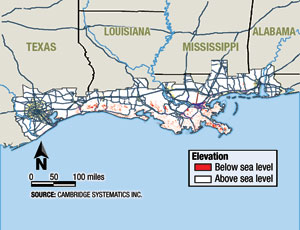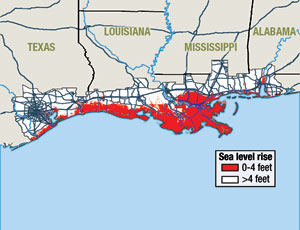The speaker repeated it twice for effect: “Nothing humans can do in mitigation between now and 2100 will affect the level of sea-level rise between now and 2100.” The rise will be substantial, possibly close to one meter, said Michael K. Orbach, professor of marine affairs and policy at Duke University Marine Laboratory, Beaufort, N.C. “We cannot stop it. All we can do in the next century is adapt to it,” he added.
Orbach was addressing 200 scientists, policy-makers and representatives of nongovernmental organizations from 24 countries attending the Nov. 18-20 Coastal Cities Summit in St. Pete Beach, Fla. The summit was the inaugural event of the International Ocean Institute– USA based at the University of South Florida, St. Petersburg. It is IOI’s first operational center in the U.S.
“We will not defend all of our coastal cities,” Orbach continued. “We’re going to abandon hundreds, if not thousands, of our coastal cities and towns over the next several hundred years.” He called for immediate planning for infrastructure based on what will be the new coastlines as well as planning for what to do with abandoned infrastructure, such as roads, railways, bridges and power lines.
“What we see now and will see in the next several decades was set in motion with the industrial revolution in the 19th century,” Orbach told ENR. Even if a treaty is negotiated to replace the Kyoto Protocol, which expires in 2012, the climate systems are so large-scale that the forecast results will be unavoidable because many fast-expanding economies, notably India and China, are not likely to join, he says.
Driving home the point was a presentation on potential impacts of climate change and land subsidence on transportation infrastructure in the central Gulf Coast area, based on a study released last March by the U.S. Dept. of Transportation in partnership with the U.S. Geological Survey. The study found that forecast climate changes over the next century could disrupt transportation services in the region, which contains 17,000 miles of highway, six of the country’s Class I railroads and four out of five of its top-tonnage ports. The region is the entry point for 60% of the nation’s petroleum imports.
“Virtually no one is planning for climate change,” said Robert C. Hyman, an associate of Cambridge Systematics, Bethesda, Md., a transportation consulting firm that participated in the DOE study. Instead, planners are continuing to base their plans on historical averages. “But infrastructure outlives projections,” he said. He recommended taking a risk-assessment approach to planning infrastructure development, because with the climate changing, the future looks to be different from what we have known.








Post a comment to this article
Report Abusive Comment